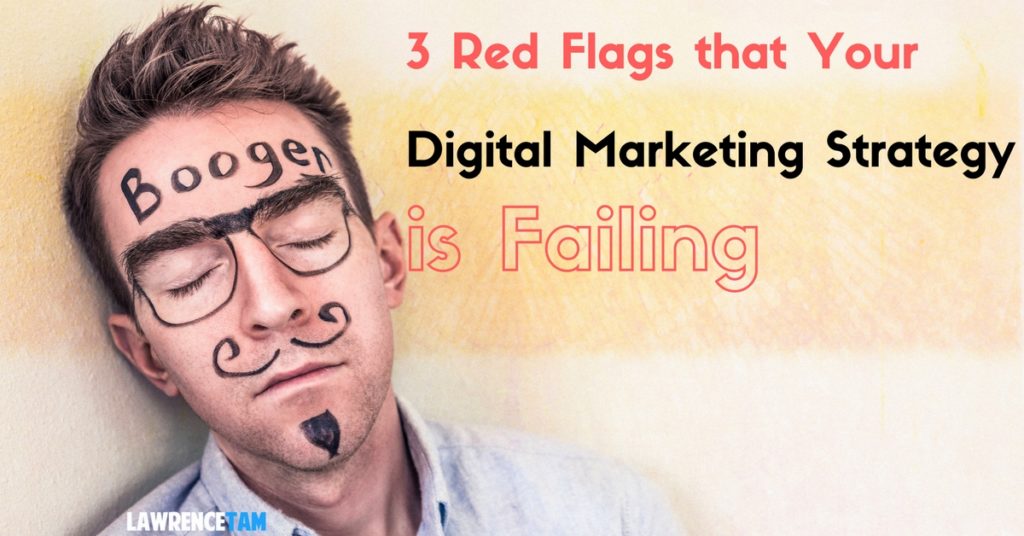Getting a marketing strategy up and running is a big hurdle for any business. Keeping the ROI high is even trickier.
So you’ve been pouring copious amounts of time and money into your digital marketing strategy, but the results just aren’t coming.
There can be many reasons as to why your approach isn’t working. In a most cases, it just requires a few small tweaks to get back on track. In others, a full revamp might be needed.
In the modern era of digital marketing, there isn’t one defined road to success. Every business has a different set of needs and resources when it comes to communicating a unique brand value proposition. However, there are a several common indicators that will tell you it’s time to step back and rethink your approach. Here are three signs to look out for.

1. You don’t have a clear image of your ideal customer.
If your marketing efforts are failing. One of the first things you need to do is examine your picture of the ideal customer. If you don’t have a clear image of their needs and concerns, it’s time to re-evaluate.
Finding your target audience is the most important part of any business. Without this knowledge, you don’t know who to focus your efforts on. Some of the indicators of this might include:
- High bounce rate on your website (particularly the home page.)
- Traffic is coming from a wide variety of sources.
- You’re losing subscribers left and right.
Keep in mind, most great marketing strategies don’t start with immediate action. They start with keen observation and analysis. Tools like Brandwatch enable you to keep eyes on what people are saying within your industry across an array of platforms. You will be able to learn exactly what consumers in your field are looking for. With these insights, it will be much easier to nail down the perfect customer and their values. You will then be able to effectively gear your marketing efforts towards the right people.
2. Website traffic is low.
You’ve spent months putting together an awesome website, but you’re not seeing enough visitors to compensate. If this is the case, there are many things you can do to increase organic traffic.
First, start with keyword evaluation. You don’t want to try and rank for the most popular keywords in your industry as the competition is most likely very high. Look into more specific/local keywords or phrases. Search engines will identify your website as a destination for a particular subject. Using the right keywords and phrases will help boost your content in the rankings so ideal customers will have an easier time finding you. Put yourself in the shoes of your target market. If you were looking for your product or service, what would you type into the search bar? Do some brainstorming then take a look at Google AdWords Keyword Planner to see which terms are trending within your industry.
Second, always be creating good, consistent content with the right keywords. Google loves fresh, relevant content. Publish content as often as you can without sacrificing quality. This is your chance to show the world that you are an expert in your field. 77 percent of internet users read blogs. If you haven’t already, consider setting up a blog section on your website. Additionally, there are a lot of free, high-traffic blogging websites like Blogger or Medium to use to get your content out there. Just be sure you are including links to relevant sources and most importantly, your website.
Third, make social media a priority. There are over 2 billion users worldwide. Omitting this crucial part of the digital marketing mix is simply not an option. Crafting a solid strategy is tough for every company. With so many users, it’s very easy to get lost in the constant stream of status updates and shared content. Do some research using tools like Mention or Hootsuite to find out what your target audience finds compelling and when is the most optimal time to post.
Guiding visitors to your website and keeping them tuned is one of the hardest tasks in the current landscape of digital marketing. You’re most likely going to experience a good deal of trial and error. Just remember to stay creative and consistent. You never know when you will strike gold.
3. You’re not tracking and measuring results properly.
One of the biggest advantages of digital marketing these days is that it can be easily recorded and tracked to give you insights on how well your strategy is working. Without the proper information and measurements on your website, content, social media, email, etc., how do you know which areas to improve upon?
While generating and measuring analytics is relatively simple, it will take time and resources to get the answers you need to move forward. Also, not everyone is a data scientist. Don’t be afraid to hire an expert. It will be well-worth it in the end.
Remember, the marketing executive calls the shots. Analytics is a top-down function. If the messages and indicators up top are unclear, the marketing strategy will be foggy as well.
Parting words.
Gaining traffic, leads, and customer engagement is a never-ending task. The digital landscape is constantly shifting and consumer mindsets are changing. If these red flags are apparent in your approach, don’t worry. It’s all part of the process. Marketing is a working progress and always will be.



0 Comments